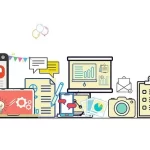What is E-CRM?
E-CRM can simply be defined as the introduction of technologies and the internet in order to ensure that customers enjoy the maximum experience from the organization irrespective of the channel that they have chosen to interact with the organization. it helps a customer-centric enterprise to formulate rules that will cover business processes across the organisation which ensures that the organisation is able to retain its customers, and not lose them to competitors.
| OBJECTIVE OF THIS ARTICLE
At the end of this article, readers should be able to understand · The role of technology in a customer-centric enterprise. · They will also understand that it is not possible to have a customer-centric enterprise without the deployment of the internet or other technology as enables.
|
E-CRM covers many aspects of the organisation. It involves deployment of applications that captures contacts, accounts, opportunities, activities, marketing, customer support, sales and service related process in the organisation.
Differences between CRM and E-CRM
#1 E-CRM is web integrated CRM
Under the conventional CRM, we have organization that tries to meet customers’ needs and do business from their perspective without giving customers the upper hand or leaving them with a choice. In E-CRM, we have a web-integrated service point that allows customers to dictate the pace of things. It is meant to improve efficiency and the rate of customer satisfaction. It is also meant to ensure that the organisation have direct contact with customers as much as possible.
#2 Technology and Architecture
Under CRM, customers’ information is completed and integrated into one single database which is made available to the various departments in the organization. This allows the staff to be able to have access to customer database anytime they want to resolve issues that have to do with them.
Through the use of the internet also, E-GRM allows Internet customers to relate with their organisation through their preferred means of communication. This makes the personalization of services easier.
#3 Enterprise-Wide Web Experience
E.CRM gives room for the deployment of the internet across the various part of the organization. Through the deployment of E-CRM, various departments in an organization are no longer constrained by walls. They can now share customers’ information and resolve customers’ issues using the Internet as an enabler.
#4 Customer Facing Web Front
E-GRM provides direct access to interfaces and performs other functions which are not directly available to traditional CRM users. Ii integrates different functions that can be performed in order to retain customer. These functions are all web based.
#5 Integration of Multiple Channels
One other thing that give E-CRM upper hand over and above traditional CRM is that, it integrates various channels. Customers that like to go to the branches can also transact business with the organization online. Lack of integration in the traditional CRM which is the order of the day in Nigeria frustrates customers who might not be at liberty to relate with organization across multiple channels.
In most banks in Nigeria for example, customers that withdraw from the counter are charged one hundred naira, this is because they are expected to use the Automated Teller Machine. This is not one of the qualities of a customer-centered enterprise. You should note that E-CRM encompasses the whole of CRM and CRM is gradually evolving into E-CRM.
CRM Implementation
Before CRM can be implemented in any organisation, there are some basic things that must be put in place so that the whole process will not fail.
#1 Business Focus
Any product-centered organisation that wish to now make customers the deciding factor of its activities must communicate his new business focus to his customer. As we all know that the main reason why businesses are established is to make profit, it is not so in a customer-centric enterprise.
This is because, when you are embarking on a customer-centric enterprise, profit will not come early because you have to divert your resources to customer satisfaction. I can assure you that when you have a loyal customer, your profits will be in leaps and bounds.
#2 Organizational Structure
This is another thing you have to address if you wish to embark on customer-centric enterprise. There is the need for you to have a flexible organizational structure so that decision making will not be delayed. You must not have an organizational structure that makes access to information about customers difficult.
You don’t need an organizational structure where the C.E.O will have to approve change of address of customers. Under the new organizational structure, staffs and partners relating to customers must be able to resolve customer’s issues without having to leave their table.
#3 Business Metrics
Another thing that is needed for a successful evolvement into a customer-centric enterprise is Business metrics, When we talk of this, we are talking about means of knowing whether we are succeeding or not. A customer-centric enterprise must be able to decide at every point in time where arc on the land and what they need to do in order to move forward.
#4 Marketing Focus
In business environment, most especially in product-centric enterprise, organisations tend to judge their performance based on how many of their products purchased. They will say Dangote cement can dictate the price of cement because it has the largest market share in the cement industry in Nigeria.
In a customer-centric enterprise, it is a different ball game: a customer-centric enterprise will never compete for market share but their primary objective will be how to meet the need of their customers and how to meet customers at the right place with the right products and services.
#5 Technology
A serious-minded customer-centric enterprise must have technology at its beck and call. This is to prevent customers from being frustrated. It also presents customers with various channels through which they can be served.
Implementation Challenges
#1 Technology Infrastructure Management
We have said that, in rolling out a customer-centric enterprise, technology must be present. Various applications must be deployed in order to ensure that customers are left with variety of choices. Note that, any technology that will be deployed must be scalable, flexible and must not contradict what the organisation already has on ground.
#2 Change Management
It has been said that one of the reasons why many l.T project failed, was because the employees were not properly integrated into the new system. Many at time, top management just come up with the suggestion of deploying an l.T technology without proper education of the employees who are likely to revolt against the innovation.
An organisation that wants to migrate to customer-centric enterprise must properly sensitize her employees. They must be made to see the reason(s) why the business philosophy has to change. Tell them that “Employees loyalty is customer’s loyalty”.
#3 Project Management
In any l.T. project, you need a Project Manager who is very conversant with what you are about to do. Although it has been said that no two I.T projects is the same, it should be stated here that before a migration to a customer-centric enterprise can be successful, there must be a Project Manager that knows what it takes for an organization to be customer-centric. He is the one that will oversee the project from the beginning to the end.
SUMMARY
In this chapter, we have looked at what E-CRM is and we said, it is web based CRM which allows customers to relate with the organisation across multiple channels. We also looked at some of the differences between traditional CRM and E-CRM which includes the fact that:
- E-CRM is web-integrated CRM;
- F-CRM technology and architecture differ from conventional CRM;
- E-CRM has heightened interactivity;
- E-CRM renders an enterprise ‘web experience’; and
- E-CRM is the CRM concept that tries to integrate multiple channels through a web access point.
We also looked at some concepts under ECRM implementation which includes Business focus, organizational structure, business metrics, marketing focus and technology. Above all, we said that, in implementing E-CRM, an organization must be involved in technology infrastructure management, change management, and CRM project management.
Brainstorming Session
- Examine the difference between CRM and E-CRM.
- Why do you think many organisations are establishing call centres for their customers?
- Which is the most important? CRM or E-CRM.
- Examine the differences between CRM and E-CRM.
- What sonic of the implementation challenges of CRM?
To Get Email Updates when we post new content, Click Here.





Leave a Reply